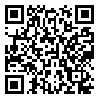Volume 7, Issue 13 (4-2017)
JRSM 2017, 7(13): 67-81 |
Back to browse issues page
Download citation:
BibTeX | RIS | EndNote | Medlars | ProCite | Reference Manager | RefWorks
Send citation to:



BibTeX | RIS | EndNote | Medlars | ProCite | Reference Manager | RefWorks
Send citation to:
Nazar poori S, Bahram A, Ghadiri F. Determining the validity and reliability of the Persian version of Infant movement motivation questionnaire (IMMQ) for 3 to 11 month children. JRSM 2017; 7 (13) :67-81
URL: http://jrsm.khu.ac.ir/article-1-2593-en.html
URL: http://jrsm.khu.ac.ir/article-1-2593-en.html
Abstract: (9474 Views)
The purpose of this study was to determine Psychometric aspects of the Persian version of Infant Movement Motivation Questionnaire (IMMQ) for infants of 3 to 11 months. In this regard, 528 parents and their infants (239 girls and 289 boys) in Tehran were selected as samples through the method of random cluster sampling. For this purpose, first by using a translation - re translation method, IMMQ was translated into Persian by 3 motor behavior experts and 2 English teaching specialists. Confirmatory and Exploratory factor analysis was used for the validation of questionnaire structure; Cronbach alpha coefficient was computed for internal consistency of questionnaire. Also, intra-class correlation coefficient under test-retest method was used to evaluate the temporal reliability of items. The results of Confirmatory and Exploratory factor analysis showed that IMMQ is multifactorial; so that, in total, four factors consisting activity, exploration, motivation and adaptability can explain % 53/32 of the total variance. Moreover, the fit indexes of the extracted model (PGFI = 0.71, NFI = 0.92, RMSEA = 0.078) were favorable and acceptable. Also, Cronbach alpha coefficient (α = 0/93) and intra-class correlation coefficient (r = 0.88) of the Persian version of IMMQ with 27 questions the like of original version, had acceptable internal consistency and temporal reliability. So the results showed that the Persian version of IMMQ can be used for clinical or research purposes as well as an educational tool for parents.
Type of Study: Research |
Subject:
motor behavior
Received: 2016/08/4 | Accepted: 2017/02/13 | Published: 2017/08/23
Received: 2016/08/4 | Accepted: 2017/02/13 | Published: 2017/08/23
References
1. V. Gregory Payne, Larry D. Isaacs (2012). Human Motor Development A Lifespan Approach. Eight Edition, McGraw-Hill Higher Education: 112-124.
2. Gallaher, D L and Osman, J (2006). Understanding Motor Development: infants, children, adolescents, adults. 6. Boston: McGraw-Hill, 11-125.
3. Osnat, A. Sarah, E. Anat, S. (2013). Assessing Motivation to Move and its relationship to motor development in infancy. Infant Behavior and Development 36, 457-469.
4. Thelen, E. (2005). Dynamic systems theory and the complexity of change. Psychoanalytic Dialogues: 15. 255–283.
5. Von Hosteen, C. (2007). Action in development. Developmental Science: 10. 54–60.
6. Adolph, K. E., Vereijken, B., & Denny, M. A. (1998). Learning to crawl. Child Development: 69. 1299–1312.
7. Doralp, S., & Bartlett, D. (2014). Infant Movement Motivation Questionnaire: Development of a measure evaluating infant characteristics relating to motor development in the first year of life. Infant Behavior and Development, 37(3), 326-333.
8. Carey, W. B., & McDevitt, S. C. (1977). The revised Infant Temperament Questionnaire. Scottsdale, AZ: Behavioural-Development Initiatives,138-145.
9. Morgan, G. A., Busch-Rossnagel, N. A., Barrett, K. C., & Harmon, R. J. (2005). The Dimensions of Mastery Questionnaire: A manual about its development, psychometrics and use. Fort Collins, CO: Colorado State University
10. Zeitlin, S., Williamson, G. G., & Szczepanski, M. (1988). Early Coping Inventory: A measure of adaptive behaviour. Bensenville. IL: Scholastic Testing Service.145-156
11. World Health Organization. (2001). the international classification of functioning, disability, and health. Geneva (CH): World Health Organization. 98-105.
12. Schutz R W GME (1993). Use, misuse, and disuse of statistics in psychology research. In Handbook of Research on Sport Psychology,112-142.
13. Thomas JR, Silverman S, Nelson J. (2015). Research Methods in Physical Activity, 7E: Human Kinetics; Champaign, Illinois,124-138.
14. Kline, R. B. (2015). Principles and practice of structural equation modeling. Guilford publications, 89-123.
15. Von Hofsten, C. (2004). An action perspective on motor development. Trends in Cognitive Sciences: 8, 266–272.
16. Zentner, M., & Bates, J. E. (2008). Child temperament: An integrative review of concepts, research programs, and measures. European Journal of Developmental Science: 2. 7–37.
17. Levtzion-Korach, O., Tennenbaum, A. Schnitzer, R. & Ornoy, A. (2000). Early motor development of blind children. Journal of Pediatrics: Child Health: 36. 226–229.
18. Stagnitti, K. (2004). Understanding play: The implications for play assessment. Australian Occupational Therapy Journal: 51, 3–12.
| Rights and permissions | |
 | This work is licensed under a Creative Commons Attribution-NonCommercial 4.0 International License. |





